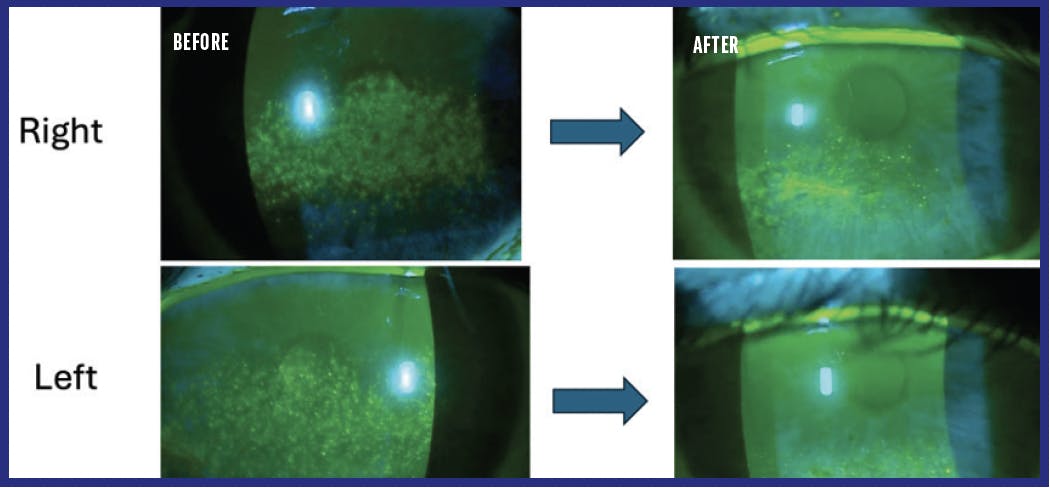The following case study is the first installment in a series of cases focused on treatment intervention with LACRIFILL Canalicular Gel (Nordic Pharma). In this case, Mile Brujic, OD, describes an occasion where LACRIFILL Canalicular Gel was used to combat the patient’s increasing symptoms of dry eye disease (DED) and meibomian gland dysfunction (MGD).
Presentation
In June 2024, a 58-year-old White woman with a medical history of depression and ocular history of LASIK OU presented with DED and MGD causing visual fluctuations. She was using perfluorohexyloctane ophthalmic solution (MIEBO, Bausch + Lomb) four times a day in both eyes, preservative-free artificial tears as needed, a heat mask once a day for both eyes for 10 minutes, brimonidine tartrate drops (Lumify, Bausch + Lomb) as needed, and a dry eye ocular nutrition formula containing omega-3s on a daily basis.
Examination of the lower lid demonstrated moderate MGD in both eyes with +2 dropout, as well as loose lid apposition in both eyes. The bulbar conjunctiva exhibited mild injection in both eyes, and the palpebral conjunctiva was clear in both eyes. The patient’s tear film demonstrated a tear film break-up time (TBUT) of 2 seconds in the right eye and 2 seconds in the left eye. The cornea showed visible LASIK scars in both eyes and +3 diffuse staining in both eyes. The patient’s anterior chamber and lens appeared clear, and the iris was normal in both eyes.
Past Ocular History
The patient had LASIK in 2019 with monovision (right eye distance and left eye near) and a TearCare procedure (Sight Sciences) in December 2022. Additionally, she had six sessions of low light therapy starting April 2024, and at first visit presentation, she was five months post insertion of 0.3 mm six-month dissolvable plugs in the upper and lower puncta OU.
The patient’s distance visual acuity measured 20/30 OD, 20/80 OS (monovision: right eye = distance, left eye = near). An InflammaDry test (QuidelOrtho) demonstrated negative results in both the right and left eye, and she had a Standardized Patient Evaluation of Eye Dryness (SPEED) score of 12.
Assessment and Plan
The patient had DED and MGD OU. The recommended treatment plan provided to the patient was to continue with MIEBO four times a day in both eyes, utilize supplemental preservative-free tears as needed, use a heat mask once a day for 10 minutes over both eyes, continue oral ocular nutrition once a day, and use Lumify as needed. Additionally, both the lower and upper canaliculi in both eyes were occluded with LACRIFILL Canalicular Gel. The patient was scheduled for a 5-month follow-up exam as the recommended reassessment following occlusion with LACRIFILL Canalicular Gel.
Outcomes and Follow-up
Upon follow-up in November 2024, the patient reported positive changes to her vision. Her visual acuity now measured 20/20 OD, 20/80 OS. InflammaDry demonstrated negative results in the right and left eye and the SPEED score improved to 6.
The patient’s TBUT improved to 4 seconds in the right eye and 4 seconds in the left eye. The corneas of both eyes improved with +1 inferior staining in both eyes (Figure).
Conclusion
The patient demonstrated significant improvement in signs and symptoms 6 months after LACRIFILL Canalicular Gel treatment was performed. At the November 2024 visit, irrigation of the upper and lower canaliculi of both eyes was performed, followed by another occlusion of the upper and lower canaliculi of both eyes with LACRIFILL Canalicular Gel. The patient was scheduled for another follow-up exam in 6 months.




